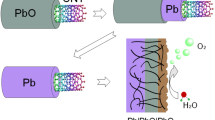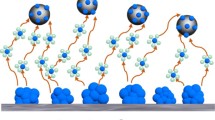Abstract
A novel micro-zone electrochemical exfoliation method for the large-scale fabrication of nitrogen-doped carbon quantum dots (N–CQDs) from pre-baked carbon anode (PCA) in ammonium bicarbonate electrolyte has been demonstrated. Therefore, an efficient (90.18 wt% utilization rate of raw material and high-yield conversion of 1.87 g(N-GQDs)g(PCA)−1 due to oxidation weight gain) and environment-friendly mass production (9.36 g in one pot) for N–CQDs really becomes promising and practical. Moreover, the N-CQDs with abundant functional groups and higher nitrogen content (30.18 at%) present strong dispersion stability and enhanced interfacial adsorption with copper substrates. By virtue of the excellent performance, we successfully applied the N–CQDs as an effective inhibitor to alleviate the corrosion of copper. Results showed the corrosion inhibition efficiency of the self-assembled N–CQDs film on the copper reached up to 96.32% at 150 mg/L N–CQDs. The mechanism for the realization of large-scale preparation and self-assembly of N–CQDs was also proposed.
Graphical Abstract







Similar content being viewed by others
References
Namdari P, Negahdari B, Eatemadi A (2017) Synthesis, properties and biomedical applications of carbon-based quantum dots: An updated review. Biomed Pharmacother 87:209–222. https://doi.org/10.1016/j.biopha.2016.12.108
Das R, Bandyopadhyay R, Pramanik P (2018) Carbon quantum dots from natural resource: A review. Mater Today 8:96–109. https://doi.org/10.1016/j.mtchem.2018.03.003
Wu M, Zhan J, Geng B, He P, Wu K, Wang L, Xu G, Li Z, Yin L, Pan D (2017) Scalable synthesis of organic-soluble carbon quantum dots: superior optical properties in solvents, solids, and LEDs. Nanoscale 9:13195–13202. https://doi.org/10.1039/c7nr04718e
Bhattacharjee L, Pal K, Jat SK, Koner AL, Ravichandran J, Bhattacharjee RR (2017) Tuning optical properties of printable carbon quantum dots using near-field environment. Carbon 125:409–418. https://doi.org/10.1016/j.carbon.2017.09.030
Molaei MJ (2019) A review on nanostructured carbon quantum dots and their applications in biotechnology, sensors, and chemiluminescence. Talanta 196:456–478. https://doi.org/10.1016/j.talanta.2018.12.042
Molaei MJ (2020) The optical properties and solar energy conversion applications of carbon quantum dots: A review. Sol Energy 196:549–566. https://doi.org/10.1016/j.solener.2019.12.036
Zhang J, Yuan X, Jiang L, Wu Z, Chen X, Wang H, Wang H, Zeng G (2018) Highly efficient photocatalysis toward tetracycline of nitrogen doped carbon quantum dots sensitized bismuth tungstate based on interfacial charge transfer. J Colloid Interf Sci 511:296–306. https://doi.org/10.1016/j.jcis.2017.09.083
Xu Q, Kuang T, Liu Y, Cai L, Peng X, Sreenivasan-Sreeprasad T, Zhao P, Yu Z, Li N (2016) Heteroatom-doped carbon dots: synthesis, characterization, properties, photoluminescence mechanism and biological applications. J Mater Chem B 4:7204–7219. https://doi.org/10.1039/c6tb02131j
Gupta NK, Verma C, Quraishi MA, Mukherjee AK (2016) Schiff’s bases derived from l-lysine and aromatic aldehydes as green corrosion inhibitors for mild steel: Experimental and theoretical studies. J Mol Liq 215:47–57. https://doi.org/10.1016/J.MOLLIQ.2015.12.027
Verma C, Verma DK, Ebenso EE, Quraishi MA (2018) Sulfur and phosphorus heteroatom-containing compounds as corrosion inhibitors: an overview. Heteroatom Chem 29:21437. https://doi.org/10.1002/hc.21437
Cui M, Ren S, Zhao H, Wang L, Xue Q (2018) Novel nitrogen doped carbon dots for corrosion inhibition of carbon steel in 1 M HCl solution. Appl Surf Sci 443:145–156. https://doi.org/10.1016/j.apsusc.2018.02.255
Cen H, Chen Z, Guo X (2019) N, S co-doped carbon dots as effective corrosion inhibitor for carbon steel in CO2-saturated 3.5% NaCl solution. J Taiwan Inst Chem E 99:224–238. https://doi.org/10.1016/j.jtice.2019.02.036
Kou X, Jiang S, Park SJ, Meng LY (2020) A review: Recent advances in preparations and applications of heteroatom-doped carbon quantum dots. Dalton T 49:6915–6938. https://doi.org/10.1039/d0dt01004a
Li Y, Li S, Wang Y, Wang J, Liu H, Liu X, Wang L, Liu X, Xue W, Ma N (2017) Electrochemical synthesis of phosphorus-doped graphene quantum dots for free radical scavenging. Phys Chem Chem Phys 19:11631–11638. https://doi.org/10.1039/c6cp06377b
Tammina SK, Yang D, Koppala S, Cheng C, Yang Y (2019) Highly photoluminescent N, P doped carbon quantum dots as a fluorescent sensor for the detection of dopamine and temperature. J Photoch Photobio B 194:61–70. https://doi.org/10.1016/j.jphotobiol.2019.01.004
Murugan N, Prakash M, Jayakumar M, Sundaramurthy A, Sundramoorthy AK (2019) Green synthesis of fluorescent carbon quantum dots from Eleusine coracana and their application as a fluorescence ‘turn-off’ sensor probe for selective detection of Cu2+. Appl Surf Sci 476:468–480. https://doi.org/10.1016/j.apsusc.2019.01.090
Zhou Q, Xia G, Du M, Lu Y, Xu H (2019) Scotch-tape-like exfoliation effect of graphene quantum dots for efficient preparation of graphene nanosheets in water. Appl Surf Sci 483:52–59. https://doi.org/10.1016/j.apsusc.2019.03.290
Riaz R, Ali M, Maiyalagan T, Anjum AS, Lee S, Ko MJ, Jeong SH (2019) Dye-sensitized solar cell (DSSC) coated with energy down shift layer of nitrogen-doped carbon quantum dots (N-CQDs) for enhanced current density and stability. Appl Surf Sci 483:425–431. https://doi.org/10.1016/j.apsusc.2019.03.236
Duo F, Wang Y, Fan C, Zhang X, Wang Y (2016) Enhanced visible light photocatalytic activity and stability of CQDs/BiOBr composites: The upconversion effect of CQDs. J Alloy Compd 685:34–41. https://doi.org/10.1016/j.jallcom.2016.05.259
Jing S, Zhao Y, Sun RC, Zhong L, Peng X (2019) Facile and high-yield synthesis of carbon quantum dots from biomass-derived carbons at mild condition. ACS Sustain Chem Eng 7:7833–7843. https://doi.org/10.1021/acssuschemeng.9b00027
Zhou L, Qiao M, Zhang L, Sun L, Zhang Y, Liu W (2019) Green and efficient synthesis of carbon quantum dots and their luminescent properties. J Lumin 206:158–163. https://doi.org/10.1016/j.jlumin.2018.10.057
Song X, Zhou Q, Zhang T, Xu H, Wang Z (2016) Pressure-assisted preparation of graphene oxide quantum dot-incorporated reverse osmosis membranes: antifouling and chlorine resistance potentials. J Mater Chem A 4:16896–16905. https://doi.org/10.1039/C6TA06636D
Lu Z, Su T, Feng Y, Jiang S, Zhou C, Hong P, Sun S, Li C (2019) Potential application of nitrogen-doped carbon quantum dots synthesized by a solvothermal method for detecting silver ions in food packaging. Int J Env Res Pub He 16:2518. https://doi.org/10.3390/ijerph16142518
Li F, Li M, Luo Y, Li M, Li X, Zhang J, Wang L (2018) The synergistic effect of pyridinic nitrogen and graphitic nitrogen of nitrogen-doped graphene quantum dots for enhanced TiO2 nanocomposites’ photocatalytic performance. Catalysts 8:438. https://doi.org/10.3390/catal8100438
Huang Y, Liao W (2019) Hierarchical carbon material of N-doped carbon quantum dots in-situ formed on N-doped carbon nanotube for efficient oxygen reduction. Appl Surf Sci 495:143597. https://doi.org/10.1016/j.apsusc.2019.143597
Munuera JM, Paredes JI, Villar-Rodil S, Ayán-Varela M, Martínez-Alonso A, Tascón JMD (2016) Electrolytic exfoliation of graphite in water with multifunctional electrolytes: en route towards high quality, oxide-free graphene flakes. Nanoscale 8:2982–2998. https://doi.org/10.1039/C5NR06882G
Tetsuka H, Asahi R, Nagoya A, Okamoto K, Tajima I, Ohta R, Okamoto A (2012) Optically tunable amino-functionalized graphene quantum dots. Adv Mater 24:5333–5338. https://doi.org/10.1002/adma.201201930
Goharshadi EK, Akhlamadi G, Mahdizadeh SJ (2015) Investigation of graphene oxide nanosheets dispersion in water based on solubility parameters: a molecular dynamics simulation study. RSC Adv 5:106421–106430. https://doi.org/10.1039/C5RA19932H
Lim SY, Shen W, Gao Z (2015) Carbon quantum dots and their applications. Chem Soc Rev 44:362–381. https://doi.org/10.1039/C4CS00269E
Shang J, Ma L, Li J, Ai W, Yu T, Gurzadyan GG (2012) The origin of fluorescence from graphene oxide. Sci Rep 2:792. https://doi.org/10.1038/srep00792
Hola K, Bourlinos AB, Kozak O, Berka K, Siskova KM, Havrdova M, Tucek J, Safarova K, Otyepka M, Giannelis EP, Zboril R (2014) Photoluminescence effects of graphitic core size and surface functional groups in carbon dots: COO− induced red-shift emission. Carbon 70:279–286. https://doi.org/10.1016/j.carbon.2014.01.008
Zhou Q, Lu Y, Xu H (2019) High-yield production of high-quality graphene by novel electrochemical exfoliation at air-electrolyte interface. Mater Lett 235:153–156
Oguzie EE, Li Y, Wang FH (2007) Corrosion inhibition and adsorption behavior of methionine on mild steel in sulfuric acid and synergistic effect of iodide ion. J Colloid Interf Sci 310:90–98. https://doi.org/10.1016/j.jcis.2007.01.038
Zhang C, Duan H, Zhao J (2016) Synergistic inhibition effect of imidazoline derivative and l-cysteine on carbon steel corrosion in a CO2-saturated brine solution. Corros Sci 112:160–169. https://doi.org/10.1016/j.corsci.2016.07.018
Lorite I, Romero JJ, Fernandez JF (2015) Influence of the nanoparticles agglomeration state in the quantum-confinement effects: Experimental evidences. AIP Adv 5(3):37105–37105. https://doi.org/10.1063/1.4914107
Li Y, Liu H, Liu XQ, Li S, Wang L, Ma N, Qiu D (2016) Free-radical-assisted rapid synthesis of graphene quantum dots and their oxidizability studies. Langmuir 32:8641–8649. https://doi.org/10.1021/acs.langmuir.6b02422
Sun L, Deng Q, Li Y, Deng L, Wang Y, Ren X, Zhang P (2016) Solvothermal synthesis of ternary Cu2O-CuO-RGO composites as anode materials for high performance lithium-ion batteries. Electrochim Acta 222:1650–1659. https://doi.org/10.1016/j.electacta.2016.11.155
Acknowledgement
The authors gratefully acknowledged financial support provided by China Postdoctoral Science Foundation (2020M672826). More importantly, I would like to thank my PhD supervisor professor H. Xu and Y. Lu (Ocean University of China) for their spiritual support and life lessons.
Author information
Authors and Affiliations
Corresponding authors
Ethics declarations
Conflict of interest
There are no conflicts to declare.
Additional information
Handling Editor: Kyle Brinkman.
Publisher's Note
Springer Nature remains neutral with regard to jurisdictional claims in published maps and institutional affiliations.
Supplementary Information
Below is the link to the electronic supplementary material.
Rights and permissions
About this article
Cite this article
Zhou, Q., Yuan, G., Lin, M. et al. Large-scale electrochemical fabrication of nitrogen-doped carbon quantum dots and their application as corrosion inhibitor for copper. J Mater Sci 56, 12909–12919 (2021). https://doi.org/10.1007/s10853-021-06102-x
Received:
Accepted:
Published:
Issue Date:
DOI: https://doi.org/10.1007/s10853-021-06102-x




